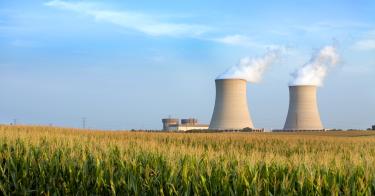Nuclear Could Be the Clean Energy Source the World Needs
Sep 17th, 2019 4 min read
 COMMENTARY BY
COMMENTARY BYKatie Tubb
Senior Policy Analyst
Katie Tubb is a senior policy analyst for energy and environmental issues in the Thomas A. Roe Institute for Economic Policy Studies.
 Nuclear power has some incredible benefits that make it a choice well worth considering as a clean energy option to improve our environment and make the world better.Allkindza/Getty Images
Nuclear power has some incredible benefits that make it a choice well worth considering as a clean energy option to improve our environment and make the world better.Allkindza/Getty ImagesKEY TAKEAWAYS
While nuclear energy has met battled persistent PR problems in the past, things seem to be changing — and rightly so.
Nuclear power is also clean in the sense that it produces a lot of energy for its small physical footprint.
Like every energy resource, nuclear power does have its tradeoffs. But even in those, reality is far better than public perceptions of nuclear energy.
Copied
The challenge to meet the world's energy needs is massive. Demand for electricity continues to grow, with nearly one billion people today still in the dark. Access to affordable, reliable, clean energy has sweeping ramifications for economic opportunity, education, clean and reliable health care, safe homes, communication — things Americans can happily take for granted.
There is a clean option that could meet this challenge: Nuclear energy. While nuclear energy has met battled persistent PR problems in the past, things seem to be changing — and rightly so.
Last year, the Clean Energy Ministerial (CEM), an annual gathering of energy ministers from 26 countries and the European Commission, included nuclear energy as a clean energy source for the first time and launched an initiative to encourage others energy organizations to do the same. According to CEM, nuclear can further "economic growth and effective environmental stewardship."
Get exclusive insider information from Heritage experts delivered straight to your inbox each week. Subscribe to The Agenda >>
CEM is not alone in reconsidering the role nuclear energy could play. In fact, the Massachusetts Institute of Technology, in partnership with Idaho National Lab and the University of Wisconsin, have gone so far as to say nuclear energy is "essential" to expand energy access and reduce greenhouse gas emissions.
There are good reasons these organizations have come to see nuclear energy as "clean."
In the United States, 19% of the electricity Americans use comes from 97 nuclear reactors, more than in any other country. There are 444 commercial nuclear power reactors operating globally, with another 54 under construction and 111 planned, most notably in China, India and Russia. The gigawatts of electricity produced for millions of people by these reactors has emitted no air pollutants.
Nuclear power is also clean in the sense that it produces a lot of energy for its small physical footprint. A single nuclear reactor uses about 13 acres of land space per megawatt, compared to wind (71 acres), solar (44 acres) and hydro (315 acres). This includes land used for mining, transportation, transmission and storage. Put another way, a solar farm would need roughly 45 square miles of land to produce the same amount of electricity as an average nuclear power plant, and a wind energy farm would need roughly 260 square miles.
Wind and solar energy enjoy a much better reputation as clean energy sources and also have benefits like zero emissions energy. However, they both require favorable weather conditions and backup power to be online in case weather doesn't cooperate. Nuclear reactors are online and generating power 93% of the time, compared with wind (37%) and solar (26%). And while most nuclear power plants in the United States are licensed to operate for 60 years, the operating life of renewables is roughly half as long.
Like every energy resource, nuclear power does have its tradeoffs. But even in those, reality is far better than public perceptions of nuclear energy.
Perhaps first among people's concerns are the infamous accidents at Chernobyl, Three Mile Island and Fukushima. It may be hard to believe, but no one has died from radiation exposure from the latter two. In the case of America's worst nuclear accident at Three Mile Island in 1979, actual radiation exposure for the 2 million people living closest to the reactor amounted to less than a dental x-ray. For decades, state and federal agencies and private companies tested agricultural, health and environmental factors, finding nothing of concern.
Less a commentary on nuclear technology than on authoritarian government, the accident at Chernobyl in 1986 resulted from an egregious, unethical Soviet experiment. The Chernobyl reactor also lacked important safety features, like containment domes, common to all US reactors. So far, the UN has confirmed 43 deaths from radiation at Chernobyl, considered the worst nuclear accident in history.
Radiation itself is another common public concern, but not well understood. Radiation is a part of our everyday lives. Flying in an airplane, eating bananas and carrots, sun bathing, getting medical scans, and simply living on planet Earth all expose a person to more radiation than living within 50 miles of a nuclear power plant. Radiation is an inherent and, to some degree, necessary feature of life.
But fear has caused unnecessary environmental harm and costs. While visiting Fukushima, founder of Environmental Progress, Michael Shellenberger challenged the Japanese government's colossal efforts to remove thousands of tons of "contaminated" topsoil. The response he got was shockingly frank: "Every scientist and radiation expert in the world who comes here says the same thing. We know we don't need to reduce radiation levels...We're doing it because the people want us to."
Among other concerns is nuclear waste. There are 81,500 tons of nuclear waste from commercial power reactors in the United States. That represents all the nuclear waste from every commercial reactor in the United States since 1957 — no more than a football field 10 yards deep. For reference, the International Renewable Energy Agency estimates the United States will have 170,000 to one million tons of waste from solar panels by 2030. While the politics of nuclear waste management have bogged down in the United States, it is a technically solvable challenge. The nuclear industry in Finland, for instance, is showing the world how it can be done by building a deep geologic repository to permanently isolate waste from people and the environment.
The point is not that nuclear power is perfect but that it has a compelling track record despite public perceptions. All energy resources have tradeoffs; there is no perfect energy resource. Nuclear power has some unique challenges. But nuclear power also has some incredible benefits that make it a choice well worth considering as a clean energy option to improve our environment and make the world better.
This piece originally appeared on CNN
